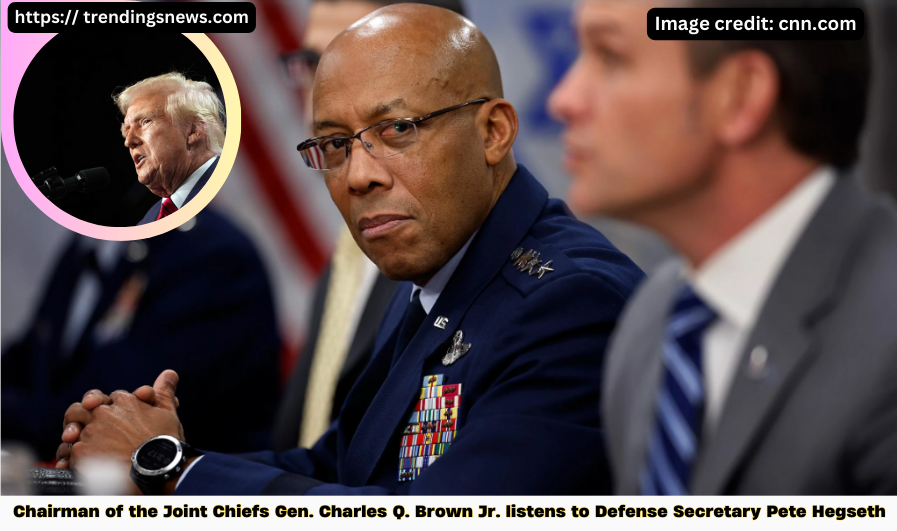In a historic and shocking move, Trump fires US military generals and Navy chief in a 2020 purge. Explore the reasons, implications, and impact of this unprecedented decision on national security and military leadership.
Introduction
The year 2020 witnessed one of the most dramatic and controversial moments in US military history.
In a shocking move, the Trump administration fired senior US military generals and Navy chiefs, including Chairman of the Joint Chiefs of Staff General Charles Q. Brown and Admiral Lisa Franchetti.
This unprecedented purge sent shockwaves through the Pentagon and raised questions about the future of military leadership, diversity, and national security.
This article delves into the details of the event, analyzes its pros and cons, and explores its broader implications for the United States.
The Unprecedented Purge of Military Leadership
Trump fires US military generals and Navy chief
On a fateful Friday night in 2020, President Donald Trump announced the dismissal of General Charles Q. Brown, the Chairman of the Joint Chiefs of Staff.
Moments later, Defense Secretary Mark Esper fired Admiral Lisa Franchetti, the Chief of the Navy, and General James Slife, the Vice Chief of the Air Force.
This sweeping purge of top military leaders was unprecedented in modern US history.
The decision to replace General Brown with retired Air Force Lt. Gen. John Dan “Razin” Caine, who was not a four-star general, raised eyebrows.
Federal law typically requires senior military officers to hold four-star positions, but Trump invoked a national interest waiver to justify the move.
The Role of Diversity and Inclusion
The removal of General Brown, the second Black man to serve as Chairman of the Joint Chiefs of Staff, and Admiral Franchetti, the first woman on the Joint Chiefs, sent a strong signal about the administration’s stance on diversity and inclusion.
The Trump administration had previously outlawed diversity initiatives across the military and government, sparking debates about representation and equality in leadership roles.
The Reasons Behind the Firings
Political Motivations and Criticism
The firings were not entirely unexpected. Rumors of a purge had circulated for weeks, with right-wing critics targeting General Brown for his perceived “woke” policies.
Trump had openly criticized military leaders he believed were more focused on social issues than national defense.
In a statement, Defense Secretary Esper emphasized that the new leadership would focus on “stopping, fighting, and winning wars.”
“However, many perceived the action as politically charged, particularly considering Trump’s track record of interfering in military justice and his divisive pardons in war crimes-related cases.”
The Role of Retired Lt. Gen. John Dan Caine
Trump’s choice of retired Lt. Gen. John Dan Caine as General Brown’s replacement was controversial. Caine, who had played a key role in the defeat of ISIS, was praised by Trump as a “warmonger” and a decisive leader.
However, his retirement status and lack of a four-star rank raised questions about the legality and wisdom of the appointment.
Pros and Cons of the Military Purge
Pros:
- Fresh Leadership: The purge brought in new leaders who aligned with Trump’s vision of a more aggressive and focused military.
- Streamlined Decision-Making: A unified leadership team could potentially make faster and more decisive decisions in times of crisis.
- Focus on National Defense: The administration argued that the new leadership would prioritize warfighting over social initiatives.
Cons:
- Loss of Experience: The dismissal of seasoned leaders like General Brown and Admiral Franchetti resulted in a loss of institutional knowledge and expertise.
- Political Interference: The move was seen as politicizing the military, undermining its traditional neutrality.
- Diversity Concerns: The removal of high-ranking Black and female officers sent a negative message about diversity and inclusion in the military.
Broader Implications for the United States
Impact on Military Morale
The sudden firings created uncertainty and anxiety among military personnel. Many questioned whether the move was based on merit or political loyalty, potentially damaging morale and trust in leadership.
National Security Concerns
The purge raised concerns about the stability of US military leadership at a time of global uncertainty. Critics argued that the abrupt changes could weaken America’s ability to respond to international threats.
The Role of the Military Justice System
The firings also highlighted tensions between the Trump administration and the military justice system.
Trump’s history of intervening in high-profile cases and his criticism of the Army’s Judge Advocate General (JAG) corps raised questions about the independence of military legal processes.
Conclusion:
The shocking 2020 purge of US military generals and Navy chiefs marked a turning point in American military history.
While the Trump administration argued that the move was necessary to refocus the military on its core mission, critics saw it as a politically motivated attack on diversity and institutional integrity.
The event also underscores the broader trend of high-profile resignations and firings under the Trump administration, including the shocking resignations of Social Security and FDA chiefs.
These departures have raised concerns about the stability and effectiveness of key government institutions.
As the United States moves forward, the lessons of this purge will continue to shape discussions about military leadership, diversity, and the role of politics in national defense.

